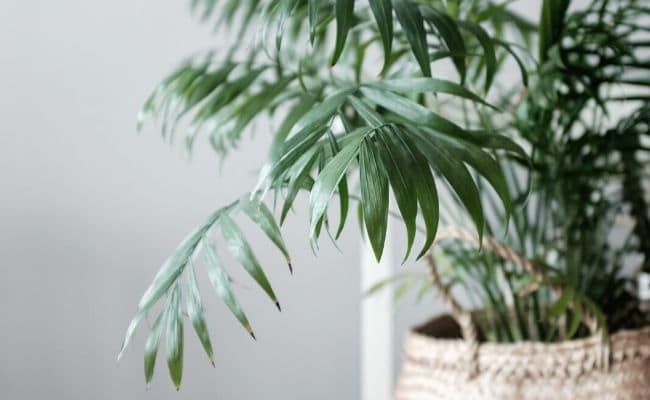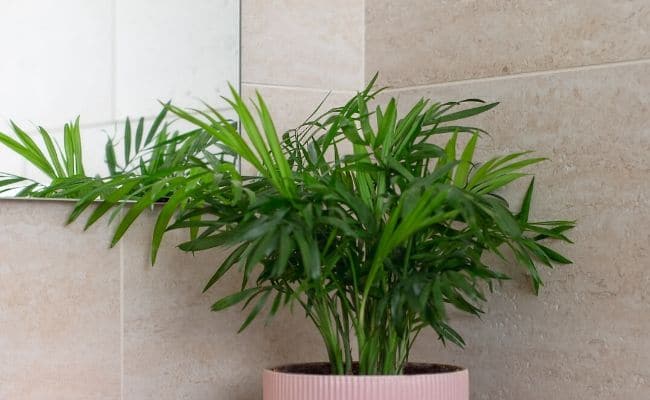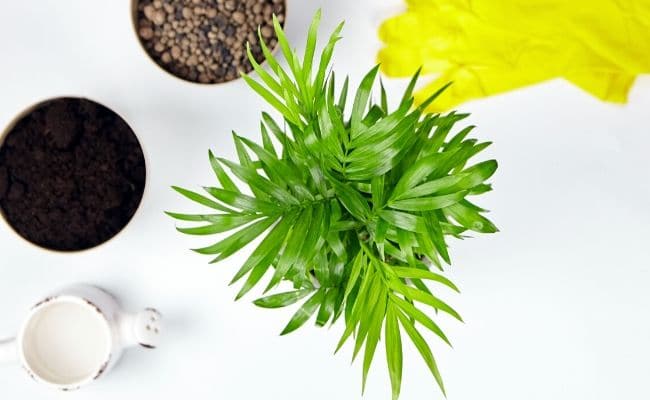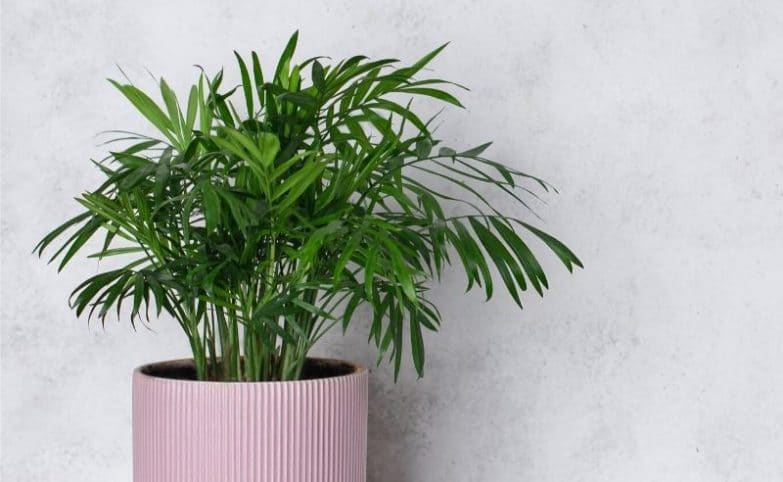Parlor Palms have been favorite houseplants since the Victorian era – their popularity has lasted longer than parlors themselves. Though quite hardy indoors, these easy-going palms are frustratingly prone to having their leaf tips turn brown. Let’s look at why your Parlor Palm has brown tips and how to restore the beauty of those elegant fronds.
Why does my parlor palm have brown tips? The most common reason why Parlor Palms get brown tips is stress from improper lighting or watering. Other reasons include overfertilization, temperature stress, water quality problems, repotting, or pests. New, unblemished leaves will restore the plant’s appearance once the issue is corrected.
How To Fix Brown Tips On Parlor Palms (Chamaedorea Elegans)
Parlor Palms, also called Neanthe Bella Palms, are all-star houseplants that adapt to low-light situations and the lack of humidity in many homes. Their slow-growing nature lets them grace a room for years without growing out of their space.
However, hardy as they are, it’s quite common for Parlor Palms to develop brown tips if they aren’t happy with their care. They aren’t finicky, so it’s not usually difficult to find out what’s bothering them. Once you fix the problem, the plant’s new growth will return to its full loveliness.
Don’t worry about an occasional dead leaf or brown tip here and there. Fronds don’t last forever; you can expect some natural attrition, especially of lower leaves. Simply prune dead fronds at the base where its stem meets the main trunk.
Damaged tips won’t repair themselves, unfortunately, but you can cut the dried ends off for appearance’s sake. Some owners make a V-shaped cut on the ends to make the damage even less noticeable.
Lighting Issues
Parlor Palms do well in bright indirect light that stays on the lower end of the spectrum. Either too little or too much can produce brown tips. Direct sunlight scorches any part of the leaf it shines upon.
Note that a Parlor palm is already a slow grower in bright indirect light and will grow even more slowly in dim conditions. This can be useful if you’d like to keep the plant at its current size, but if you want growth it will need sufficient illumination.
Here are more lighting tips:
- A good way to test your Parlor Palm’s light is to see if it casts a shadow. This doesn’t have to be a defined, sharp-edged outline; the light will be sufficient if it’s strong enough to cast a shape.
- If your Palm is next to a window, an east- or north-facing exposure is best. These generous plants do well in artificial light, too.
- Be careful about bringing the plant outdoors for the summer. They sunburn easily unless kept in deep shade.

Watering Issues Causing Brown Tips On Parlor Palms
A Parlor Palm isn’t exactly tricky to water, but they do require some attention. They want their roots to stay slightly moist and will get upset if the soil dries out. Lack of moisture is a big cause of brown leaf tips.
Overwatering can cause the same symptoms, but it’s even more dangerous: soggy soil may trigger root rot that can kill the plant outright. Though Parlor Palms use more water when grown in bright light, they are not what you’d call thirsty plants.
Only water once the top half-inch of soil feels dry. Rather than watering on a schedule, assess the plant and soil for dryness to determine the right time to water. Read this article for more tips on assessing houseplant watering needs.
When it’s time, water so thoroughly that excess water drains out the exit holes: this ensures the entire root ball is moistened, and it helps flush the soil of residual chemicals.
Factors That Affect Watering
Your Parlor Palm’s pot and its soil make a big difference in how easy it is to water correctly:
Soil: A light, well-draining medium preserves aeration for the roots even after a thorough soaking. The plant isn’t picky about pH; a decent retail potting mix is usually fine. If the soil doesn’t drain well enough, add an aerating amendment like coarse sand, pumice, or coco coir. Read my guide to houseplant soil here.
Pot: An unglazed pot allows the soil to breathe better and helps prevent soggy soil. Read more info on choosing pots for your houseplants here.
Drainage: This isn’t so much a factor as a requirement. Your plant’s container must have adequate drainage, whether it’s a large single hole or several smaller ones. An inner lower layer of pebbles won’t replace drainage holes: pebbles raise the water level and create a stagnant pool of water at the bottom of the pot.
Does Your Parlor Palm Have Brown Tips Due To Mineralized Tapwater?
If the water you use is heavily mineralized, the excess can be reflected in the leaves. Chlorine and/or chloramine added to municipal water may add to the issue, but heavy mineral content can affect your plant even if the water is dechlorinated.
If you’re seeing unexplained brown tips on your Parlor Palm, try switching to filtered water, rainwater, or distilled water. Read more about the impact of water type on your houseplants.
Note: Flushing the soil regularly may keep the residue level low enough that marginal tapwater doesn’t cause a problem. If you want to avoid the expense and inconvenience of finding an alternative water source, try flushing the soil first and see if the brown tip problem improves.
Humidity Factors
Parlor Palms cope with low humidity better than most houseplants, but a dry environment can still contribute to brown tips.
Here are sometimes overlooked factors that affect the air’s moisture level:
Heat: Plants near a heat source tend to dry out faster. Parlor Palms are not overly sensitive to heated homes – palm-loving Victorians had fireplaces in their parlors, after all – but proximity to a heat source makes a difference.
Cold: Cold air offers a lower saturation pressure point for water vapor, which translates into drier conditions.
Inadequate Watering: Low humidity plus a lack of soil moisture equals dried out plant parts; conversely, if you keep a Parlor palm correctly watered, low humidity won’t matter as much.

Overfertilization
Fertilizer burn can cause brown tips … and it’s an easy mistake to make. Parlor Palms aren’t heavy feeders.
Here’s how to stay out of trouble:
- Use a liquid solution of fertilizer diluted to at least half the amount recommended on the label.
- Organic fertilizers are less likely to cause overfeeding and therefore safer, but a synthetic blend is fine if carefully applied.
- It’s recommended to feed just twice during the growing season, though some growers dilute the formula even more and feed monthly.
- A formula higher in nitrogen works well.
- Whichever regimen you use, don’t fertilize at all during the cool season.
Another reason for your Parlor Palm getting brown tips is chemical burn from residue salts left behind by unabsorbed fertilizer. This is why regularly flushing the soil is a sound practice.
Simply run extra water through the soil at watering time: the runoff carries out excess minerals. Let the container drain well. Repeat one or more times if you suspect a buildup. Read my guide to fertilizing houseplants to learn more.
Repotting Stress
A Parlor Palm often develops brown tips after repotting. The plant’s root system is rather small and weak, so it’s easily damaged. If you’ve recently repotted and suspect this is the issue, all you can do is give the plant good care while it recovers.
The good news is that Parlor Palms don’t need to be repotted frequently. They don’t mind a bit of crowding and can thrive in a relatively small pot. A young plant may need yearly repotting, but a mature plant can stay in the same container for many seasons.
It’s best to wait to repot until the plant has a solid rootball that fills the entire space of the pot. (Gently unpot the plant to check.)
These tips will make repotting less stressful:
- Repot at the start of the growing season.
- Only go up one pot size. Empty soil can retain too much moisture.
- Use soil with the same composition as the old mix. You can add drainage amendments if the former soil was inferior, but don’t use a radically different medium.
- Be gentle and try not to disturb the roots or soil. Don’t knock or hose off old soil from the root ball, just place it gently in the new pot with fresh soil at the bottom and refill the sides.

Temperature Stress
Cold temperatures or a draft can easily give your Parlor Palm brown tips. The plant does best in warm daytime temperatures from 70ºF (21ºC) to 80ºF (27ºC) and likes to cool down by 10ºF at night. It can tolerate short dips below this range but will perish in a frost.
Parlor Palms can live outside year-round in USDA Zones 10-12, but the plant is more useful and interesting as a houseplant. Many large and interesting species thrive outdoors but can’t be tamed for indoor living the way a loveable Parlor Palm can.
Pest Damage
A pest infestation offers delightful symptoms of leaf spots, sticky areas, and deformed foliage, as well as causing your Parlor Palm brown tips. The most common Parlor Palm pest is the tiny spider mite that takes up residence in dry, dusty leaves and stem joints.
These little arachnids leave small webs and damaged foliage in their wake. Giving your plant a weekly shower helps dissuade these pests.
Spider mites can be persistent, but one effective, low-toxicity treatment is horticultural soap. You’ll need to cover the plant so that the soapy solution touches each mite – once dry, the insecticide loses effectiveness. Learn more about getting rid of spider mites here.
If the plant is small enough, one easy and comprehensive method is to submerge the plant’s foliage in a basin or sink filled with soapy water for about a minute to let the pesticide do its magic.
You can spray the plant thoroughly if it’s too big to dunk, but get the solution into every joint and under each leaf. With either method, repeating weekly for a month to six weeks should clear the infestation.
Can I Cut Off The Brown Tips On My Parlor Palm?
The most important thing to do is to find out why your Parlor Palm is getting brown tips and fix the issue. If you don’t like the look of the brown tips, you can cut them off. However, don’t cut into the healthy green part of the frond, as this will cause the brown tip to recur. Just cut most of the brown area off, leaving a small margin of brown frond.
Some people like to cut the brown tips into a point, so they look more like a healthy frond. This is perfectly ok to do.
If the entire frond is turning brown, the best course of action is to prune the entire frond off close to the soil line. Some people recommend waiting until the frond is completely brown, as the plant will still be gaining energy from the partly browning frond.

